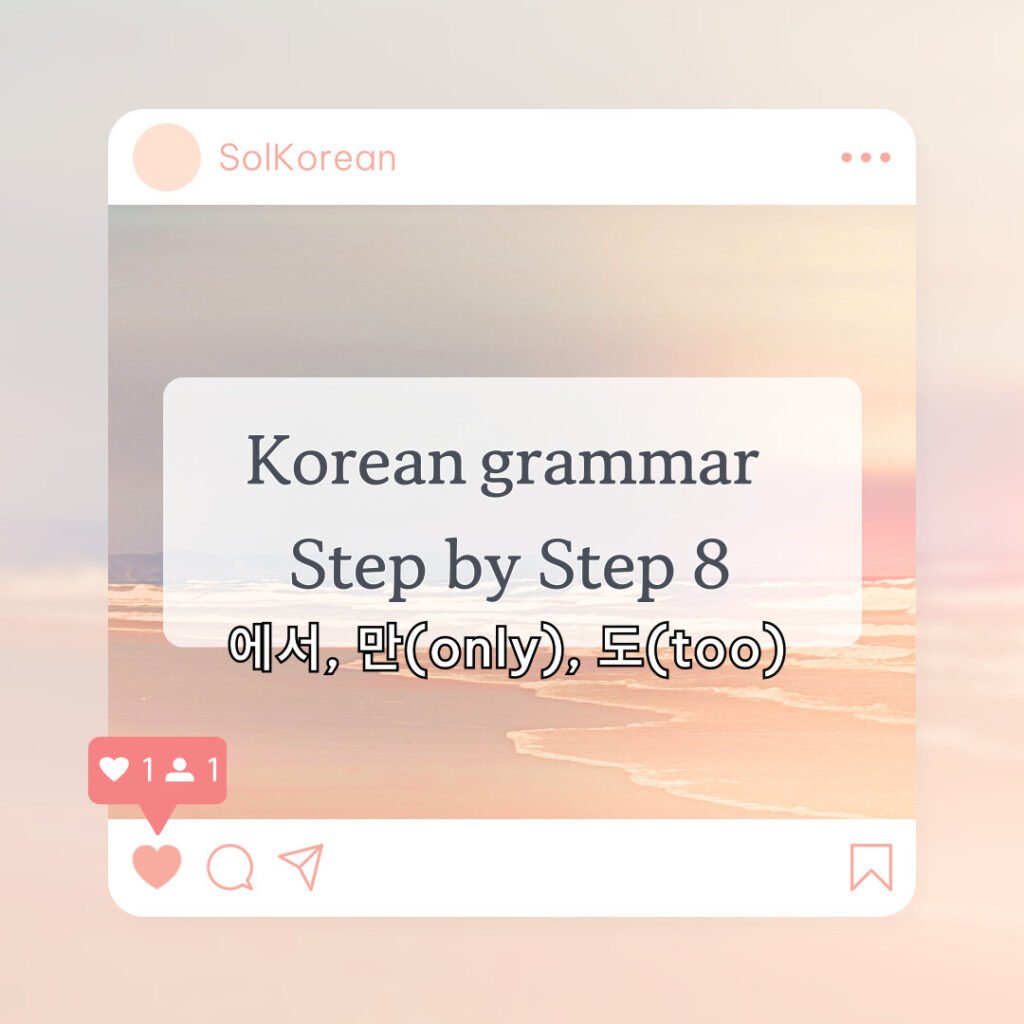에서 vs 에, 만(only), and 도(too) grammar
Hello, language learners! Welcome back to our journey of mastering Korean.
Today, we will practice forming sentences while learning new grammar concepts! This post will introduce you to the particles “도” (too), “만” (only), and “에서” (at, in, from). These are essential for constructing more nuanced and expressive sentences in Korean.
Additionally, we will provide practical and useful tips to help you grasp Korean grammar more effectively.
So, don’t skip any sections—let’s practice everything together and enhance your Korean language skills step by step!
Let’s dive in!
Part 1,
Let’s grasp the concept of grammar
In the 4th post, we studied the location, time, and date particle “에”. While “에” is generally used to indicate time and dates, when it comes to locations, we have two particles: “에” and “에서“.
“에서”: Used for indicating where an action takes place and origins.
“에” is used for indicating static locations, while “에서” indicates where an action takes place.
Let’s look at these two examples:
- I’m at home.
- I work at home.
In both sentences, “at home” is the location, but we use different particles because of the different verbs.
(1) I’m at home. (집에 있어요.) Here, the location is static, so we use “에“.
(2) I work at home. (집에서 일해요.) Here, an action is taking place, so we use “에서“.
So in Korean, to indicate a certain place, we always have to look at the verb.
Most of the time, things are happening in a place, so besides the verbs “be” verb like “am, are, is”, we often use “에서” for locations where actions occur.
(1) I’m at a cafe
(2) I drink coffee at a cafe
For (1), we will use 에 to indicate “at”,
For (2), we will use “에서” to indicate “at”, since “Drink” is an action verb.
So, It will be:
(1) I’m at a cafe. (카페에 있어요.)
(2) I drink coffee at a cafe. (카페에서 커피를 마셔요.)
Perfect! “에서” has another usage, which means “from”,
to indicate origin or the starting point of an action or movement.
ex) 집에서 출발해요. (I depart/leave from home.)
회사에서 이제 가요 (I’m leaving from my company now)
So, for the origin, we use “에서”.
And for the destination, we use “에”!
Destination vs. Origin:
Use “에” for destinations (usually for “go to” is always “에 가요”)
Example: 도서관에 가요. (I am going to the library.)
Use “에서” for origins (where you come from).
Example: 미국에서 왔어요. (I came from America.)
<Summary>
Use “에” for static locations, destinations, time, or dates.
Use “에서” for locations where actions happen and to indicate the origin or starting point of an action.
Please don’t get confused! To indicate time or dates, it’s always “에”. Many Korean learners often mix this up.
“에서” only has two usages: one is to indicate locations, and the other is to indicate “from”.
To say “on Monday(월요일에)” or “at 12(12시에)” or “in August(8월에)”,
like these time-related expressions, we always use “에“.
Here, by creating examples, you will deepen your understanding.
Let’s try this together!
1. I study at school in the afternoon.
(study:공부하다/ school: 학교 / afternoon: 오후)
2. My manager works at an office in the evening.
(manager:매니저 / work:일하다/ office: 사무실/ evening: 저녁)
3. Do you go there from your house?
(go: 가다/ there:거기 / house:집 )
* Questions keep the same order as the normal statement order, just need to raise the voice at the end.
4. My mom exercises in the gym every Saturday.
(exercise:운동하다/ gym:헬스장 / every: 마다 / Saturday: 토요일)
5. See (you) in Gangnam tonight.
(see:보다 / gangnam: 강남/ tonight: 오늘 밤(today night) )
6. I sometimes do homework at my friend’s house.
(do:하다 / sometimes: 가끔/ friend:친구 / house:집)
7. My husband works in the living room, and I work at the library.
(husband: 남편/ work:일하다 / living room : 거실 / library: 도서관)
8. When do you depart from the airport?
(when:언제 / depart:출발하다 / airport:공항)
* You can put “when” at the beginning of the sentence.
9. Where do you work? Where do you live?
(where:어디 / work: 일하다 / live: 살다)
10. Where and when do we meet tomorrow?
(where:어디 / when: 언제/ meet: 만나다 / tomorrow: 내일)
Thy these on your own first, before checking the answers!
These are the answers:
1. I study at school in the afternoon.
(study:공부하다/ school: 학교 / afternoon: 오후)
오후에 학교에서 공부해요.
* Remember the general sentence order? Subject-Time-location-object-verb! (But if you want to put slight emphasis on the location, you can say “학교에서 오후에 공부해요.”)
* To indicate time(afternoon), we use “에”, and since the verb is an action verb (to study), we use “에서” to indicate “at”.
2. My manager works at an office in the evening.
(manager:매니저 / work:일하다/ office: 사무실/ evening: 저녁)
내 매니저는 저녁에 사무실에서 일해요.
* To indicate time(evening), we use “에”, and since the verb is an action verb (to work), we use “에서” to indicate “at”.
3. Do you go there from your house?.
(go: 가다/ there:거기 / house:집 )
(너는) 집에서 거기에 가요?
* Questions keep the same order as the normal statement order, just need to raise the voice at the end.
* We don’t have words like “Do” or “Does” to form questions as in English. Just start with the subject.
* When asking “you,” the subject is usually clear, so you wouldn’t necessarily need to include “너.”
* Here, “Your house” is the origin or departing place, so we will use “에서.”
* “Go to a place” is always “에 가다.” (it’s a destination), so “거기에 가요.”
4. My mom exercises in the gym every Saturday.
(exercise:운동하다/ gym:헬스장 / every: 마다 / Saturday: 토요일)
우리 엄마는 토요일마다 헬스장에서 운동해요.
* every(마다) goes after a noun! every Sunday: 일요일마다. every morning: 아침마다
You don’t use 에 here because 마다(every) replaces its usage.
* The verb is an action verb (to exercise), we use “에서” to indicate “in”.
5. See (you) in Gangnam tonight.
(see:보다 / gangnam: 강남/ tonight: 오늘 밤(today night) )
오늘밤에 강남에서 봐요
* When talking to “you,” the subject is usually clear, so you wouldn’t necessarily need to include “너.”
* To indicate time(tonight), we use “에”, and since the verb is an action verb (to see), we use “에서” to indicate “in”.
* “Tonight” is a word combined with “오늘” (today) + “밤” (night).
6. I sometimes do homework at my friend’s house.
(do:하다 / sometimes: 가끔/ friend:친구 / house:집)
가끔 친구집에서 숙제 해요.
* You can change the order. 친구집에서 가끔 숙제 해요. (“숙제하다” is like one word for us, so we put “가끔” in front of it.)
* The verb is an action verb (to do homework), we use “에서” to indicate “at”.
* Do you remember the usage of ” ‘s ” in Korean? We have a word for it, which is “의”. So you could say 친구의 집에서, but it sounds unnatural. Often, we omit the “‘s” part, “의”.
7. My husband works in the living room, and I work at the library.
(husband: 남편/ work:일하다 / living room : 거실 / library: 도서관)
내 남편은 거실에서 일해요. 그리고 나는 도서관에서 일해요
* 내 남편/우리 남편 both are commonly used.
* Here, there’s a contrast between me and my husband. In this case, using the 은/는 particle sounds natural.
* The verb is an action verb (to work), we use “에서” to indicate “in and at”.
8. When do you depart from the airport?
(when:언제 / depart:출발하다 / airport:공항)
언제 공항에서 출발해요?
* “the airport” is the origin or departing place, so we will use “에서.” to indicate “from”
* This is the general sentence order, but you can change it.
공항에서 언제 출발해요 also sounds natural, with a bit more emphasis on “공항” (airport) than “언제” (when).
9. Where do you work? Where do you live?
(where:어디 / work: 일하다 / live: 살다)
어디에서 일해요? 어디에 살아요?
* Here’s the thing: “어디 (where)” is also a location-indicating word, so we put “에” or “에서” after 어디.
* “work” is an action verb, we use “에서”
* We use both “어디에” and “어디에서” for the verb “살다 (to live).”
It’s hard to define whether “to live” is a static verb or not, so you’ll hear both used.
However, I think “어디에 살아요” is slightly more common than “어디에서 살아요”!
10. Where and when do we meet tomorrow?
(where:어디 / when: 언제/ meet: 만나다 / tomorrow: 내일)
어디에서 언제 우리 내일 만나요?
* We start with the question word, then maintain the general sentence order!
* No need to mention the “and” part here.
* We are using “에서” after “어디” (where) since the verb is “meet (만나다),” an action verb!
Great job! Let’s practice a bit more, I’ll teach you how we can say “only” or “too” in Korean!
만: Meaning “only“, used attached behind a noun
도 : Meaning “too, as well and even“, used attached behind a noun
만 : The particle “만” is attached directly to nouns, pronouns, or even verbs to indicate “only” or “just.”
You can place 만 instead of other particles. So subject/object’s particles are not used when you use 만.
Examples:
물만 마셔요. (I only drink water.)
나만 일해요. (Only I work.)
공부만 해요. (I only study)
아이들은 초콜릿만 좋아해요. (Kids only like chocolate.)
Let’s practice using “만”.
Try translating these sentences into Korean:
- I only watch TV. (emphasis on TV)
- Only my friend knows. (emphasis on my friend)
- She only sings. (emphasis on sings)
Answers:
나는 TV만 봐요.
내 친구만 알아요.
그 여자는 노래만 해요.
도: The particle “도” is used to indicate “also” or “even,” and it can be attached to nouns, pronouns, and verbs.
Example:
Me too : 나도
You too: 너도
I like BTS, too : 나도 BTS 좋아해
I also work: 나도 일해요.
Depending on where you place “도” in a sentence, the meaning can change significantly. Let’s look at these examples:
- 나도 한국어를 공부해요.
- Emphasis: “I”
- Meaning: Others study Korean, and “I” do as well.
- 나는 한국어도 공부해요.
- Emphasis: “Korean”
- Meaning: I study other languages (like Chinese and Japanese), and Korean is included among them.
- 나는 한국어 공부도 해요
- Emphasis: “Study”
- Meaning: I do many other things, and I also study
By shifting “도” to different parts of the sentence, you can highlight different aspects!
And lastly, “도” can also mean “even”
1. 걔는 일요일에도 일해요 : He/ She works even on Sunday.
2. 어린이도 이해할 수 있어요 : Even children can understand.
3. 저는 물도 안 마셔요. : I don’t even drink water.
Now let’s practice more by creating sentences
Let’s do this together!
1. I also go to the concert today
(go: 가다/ concert: 콘서트 / today: 오늘)
2. Are you eating pizza now? I’m eating too (try it very casually!)
(eat:먹다 / now:지금)
* you can use normal present tense conjugation!
3. I hang out only with Korean friends (pretty formally!)
(hang out: 놀다/ with:하고 / friend:친구)
4. I concentrate only at a library.
(concentrate:집중하다/ library:도서관)
5. I’m busy. So I take Korean classes only on Thursday.
(busy:바쁘다 / so: 그래서/ take class: 수업(을) 듣다/ Thursday: 목요일)
6. I don’t like that drama either!
(like:좋아하다 / drama: 드라마)
7. I speak English and French. And I also speak Korean.
(speak: 말하다/ English:영어 / and:하고 / French: 프랑스어 Korean : 한국어)
* “to speak” is 말하다. But when referring to speaking a language, we use the verb “하다” (to do) combined with the name of the language.






